Haoran Tang
Sharpness-Aware Machine Unlearning
Jun 16, 2025Abstract:We characterize the effectiveness of Sharpness-aware minimization (SAM) under machine unlearning scheme, where unlearning forget signals interferes with learning retain signals. While previous work prove that SAM improves generalization with noise memorization prevention, we show that SAM abandons such denoising property when fitting the forget set, leading to various test error bounds depending on signal strength. We further characterize the signal surplus of SAM in the order of signal strength, which enables learning from less retain signals to maintain model performance and putting more weight on unlearning the forget set. Empirical studies show that SAM outperforms SGD with relaxed requirement for retain signals and can enhance various unlearning methods either as pretrain or unlearn algorithm. Observing that overfitting can benefit more stringent sample-specific unlearning, we propose Sharp MinMax, which splits the model into two to learn retain signals with SAM and unlearn forget signals with sharpness maximization, achieving best performance. Extensive experiments show that SAM enhances unlearning across varying difficulties measured by data memorization, yielding decreased feature entanglement between retain and forget sets, stronger resistance to membership inference attacks, and a flatter loss landscape.
Video SimpleQA: Towards Factuality Evaluation in Large Video Language Models
Mar 24, 2025



Abstract:Recent advancements in Large Video Language Models (LVLMs) have highlighted their potential for multi-modal understanding, yet evaluating their factual grounding in video contexts remains a critical unsolved challenge. To address this gap, we introduce Video SimpleQA, the first comprehensive benchmark tailored for factuality evaluation of LVLMs. Our work distinguishes from existing video benchmarks through the following key features: 1) Knowledge required: demanding integration of external knowledge beyond the explicit narrative; 2) Fact-seeking question: targeting objective, undisputed events or relationships, avoiding subjective interpretation; 3) Definitive & short-form answer: Answers are crafted as unambiguous and definitively correct in a short format, enabling automated evaluation through LLM-as-a-judge frameworks with minimal scoring variance; 4) External-source verified: All annotations undergo rigorous validation against authoritative external references to ensure the reliability; 5) Temporal reasoning required: The annotated question types encompass both static single-frame understanding and dynamic temporal reasoning, explicitly evaluating LVLMs factuality under the long-context dependencies. We extensively evaluate 41 state-of-the-art LVLMs and summarize key findings as follows: 1) Current LVLMs exhibit notable deficiencies in factual adherence, particularly for open-source models. The best-performing model Gemini-1.5-Pro achieves merely an F-score of 54.4%; 2) Test-time compute paradigms show insignificant performance gains, revealing fundamental constraints for enhancing factuality through post-hoc computation; 3) Retrieval-Augmented Generation demonstrates consistent improvements at the cost of additional inference time overhead, presenting a critical efficiency-performance trade-off.
Dual Mutual Learning Network with Global-local Awareness for RGB-D Salient Object Detection
Jan 03, 2025Abstract:RGB-D salient object detection (SOD), aiming to highlight prominent regions of a given scene by jointly modeling RGB and depth information, is one of the challenging pixel-level prediction tasks. Recently, the dual-attention mechanism has been devoted to this area due to its ability to strengthen the detection process. However, most existing methods directly fuse attentional cross-modality features under a manual-mandatory fusion paradigm without considering the inherent discrepancy between the RGB and depth, which may lead to a reduction in performance. Moreover, the long-range dependencies derived from global and local information make it difficult to leverage a unified efficient fusion strategy. Hence, in this paper, we propose the GL-DMNet, a novel dual mutual learning network with global-local awareness. Specifically, we present a position mutual fusion module and a channel mutual fusion module to exploit the interdependencies among different modalities in spatial and channel dimensions. Besides, we adopt an efficient decoder based on cascade transformer-infused reconstruction to integrate multi-level fusion features jointly. Extensive experiments on six benchmark datasets demonstrate that our proposed GL-DMNet performs better than 24 RGB-D SOD methods, achieving an average improvement of ~3% across four evaluation metrics compared to the second-best model (S3Net). Codes and results are available at https://github.com/kingkung2016/GL-DMNet.
PhysGame: Uncovering Physical Commonsense Violations in Gameplay Videos
Dec 02, 2024



Abstract:Recent advancements in video-based large language models (Video LLMs) have witnessed the emergence of diverse capabilities to reason and interpret dynamic visual content. Among them, gameplay videos stand out as a distinctive data source, often containing glitches that defy physics commonsense. This characteristic renders them an effective benchmark for assessing the under-explored capability of physical commonsense understanding in video LLMs. In this paper, we propose PhysGame as a pioneering benchmark to evaluate physical commonsense violations in gameplay videos. PhysGame comprises 880 videos associated with glitches spanning four fundamental domains (i.e., mechanics, kinematics, optics, and material properties) and across 12 distinct physical commonsense. Through extensively evaluating various state-ofthe-art video LLMs, our findings reveal that the performance of current open-source video LLMs significantly lags behind that of proprietary counterparts. To bridge this gap, we curate an instruction tuning dataset PhysInstruct with 140,057 question-answering pairs to facilitate physical commonsense learning. In addition, we also propose a preference optimization dataset PhysDPO with 34,358 training pairs, where the dis-preferred responses are generated conditioned on misleading titles (i.e., meta information hacking), fewer frames (i.e., temporal hacking) and lower spatial resolutions (i.e., spatial hacking). Based on the suite of datasets, we propose PhysVLM as a physical knowledge-enhanced video LLM. Extensive experiments on both physical-oriented benchmark PhysGame and general video understanding benchmarks demonstrate the state-ofthe-art performance of PhysVLM.
PPLLaVA: Varied Video Sequence Understanding With Prompt Guidance
Nov 05, 2024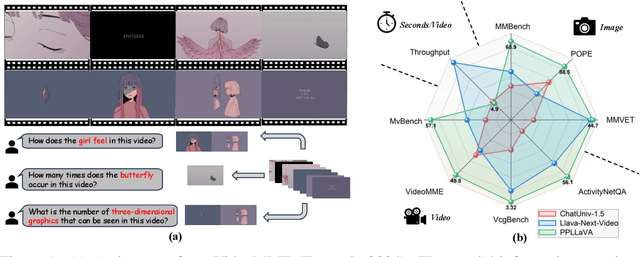

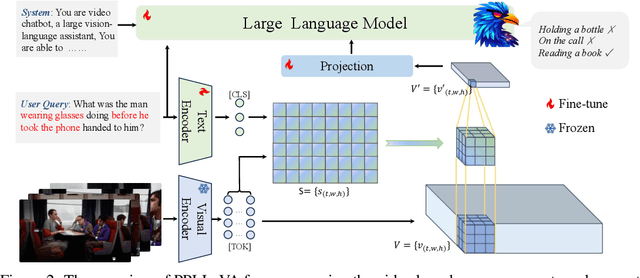
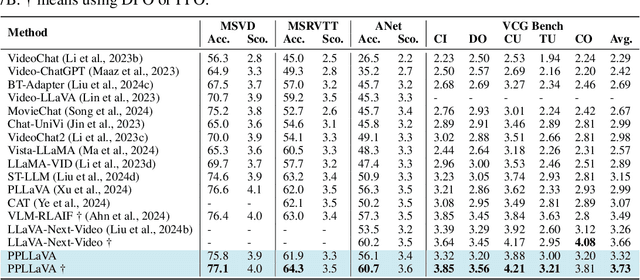
Abstract:The past year has witnessed the significant advancement of video-based large language models. However, the challenge of developing a unified model for both short and long video understanding remains unresolved. Most existing video LLMs cannot handle hour-long videos, while methods custom for long videos tend to be ineffective for shorter videos and images. In this paper, we identify the key issue as the redundant content in videos. To address this, we propose a novel pooling strategy that simultaneously achieves token compression and instruction-aware visual feature aggregation. Our model is termed Prompt-guided Pooling LLaVA, or PPLLaVA for short. Specifically, PPLLaVA consists of three core components: the CLIP-based visual-prompt alignment that extracts visual information relevant to the user's instructions, the prompt-guided pooling that compresses the visual sequence to arbitrary scales using convolution-style pooling, and the clip context extension designed for lengthy prompt common in visual dialogue. Moreover, our codebase also integrates the most advanced video Direct Preference Optimization (DPO) and visual interleave training. Extensive experiments have validated the performance of our model. With superior throughput and only 1024 visual context, PPLLaVA achieves better results on image benchmarks as a video LLM, while achieving state-of-the-art performance across various video benchmarks, excelling in tasks ranging from caption generation to multiple-choice questions, and handling video lengths from seconds to hours. Codes have been available at https://github.com/farewellthree/PPLLaVA.
A Peaceman-Rachford Splitting Approach with Deep Equilibrium Network for Channel Estimation
Oct 31, 2024Abstract:Multiple-input multiple-output (MIMO) is pivotal for wireless systems, yet its high-dimensional, stochastic channel poses significant challenges for accurate estimation, highlighting the critical need for robust estimation techniques. In this paper, we introduce a novel channel estimation method for the MIMO system. The main idea is to construct a fixed-point equation for channel estimation, which can be implemented into the deep equilibrium (DEQ) model with a fixed network. Specifically, the Peaceman-Rachford (PR) splitting method is applied to the dual form of the regularized minimization problem to construct fixed-point equation with non-expansive property. Then, the fixed-point equation is implemented into the DEQ model with a fixed layer, leveraging its advantage of the low training complexity. Moreover, we provide a rigorous theoretical analysis, demonstrating the convergence and optimality of our approach. Additionally, simulations of hybrid far- and near-field channels demonstrate that our approach yields favorable results, indicating its ability to advance channel estimation in MIMO system.
MUSE: Mamba is Efficient Multi-scale Learner for Text-video Retrieval
Aug 20, 2024
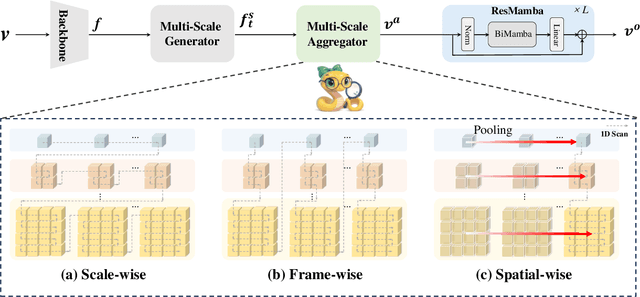


Abstract:Text-Video Retrieval (TVR) aims to align and associate relevant video content with corresponding natural language queries. Most existing TVR methods are based on large-scale pre-trained vision-language models (e.g., CLIP). However, due to the inherent plain structure of CLIP, few TVR methods explore the multi-scale representations which offer richer contextual information for a more thorough understanding. To this end, we propose MUSE, a multi-scale mamba with linear computational complexity for efficient cross-resolution modeling. Specifically, the multi-scale representations are generated by applying a feature pyramid on the last single-scale feature map. Then, we employ the Mamba structure as an efficient multi-scale learner to jointly learn scale-wise representations. Furthermore, we conduct comprehensive studies to investigate different model structures and designs. Extensive results on three popular benchmarks have validated the superiority of MUSE.
Why does in-context learning fail sometimes? Evaluating in-context learning on open and closed questions
Jul 02, 2024



Abstract:We measure the performance of in-context learning as a function of task novelty and difficulty for open and closed questions. For that purpose, we created a novel benchmark consisting of hard scientific questions, each paired with a context of various relevancy. We show that counter-intuitively, a context that is more aligned with the topic does not always help more than a less relevant context. This effect is especially visible for open questions and questions of high difficulty or novelty. This result reveals a fundamental difference between the treatment of close-form and open-form questions by large-language models and shows a need for a more robust evaluation of in-context learning on the variety of different types of questions. It also poses a new question of how to optimally select a context for large language models, especially in the context of Retrieval Augmented Generation (RAG) systems. Our results suggest that the answer to this question can be highly application-dependent and might be contingent on factors including the format of the question, the perceived difficulty level of the questions, and the novelty or popularity of the information we seek.
Toward Structure Fairness in Dynamic Graph Embedding: A Trend-aware Dual Debiasing Approach
Jun 19, 2024



Abstract:Recent studies successfully learned static graph embeddings that are structurally fair by preventing the effectiveness disparity of high- and low-degree vertex groups in downstream graph mining tasks. However, achieving structure fairness in dynamic graph embedding remains an open problem. Neglecting degree changes in dynamic graphs will significantly impair embedding effectiveness without notably improving structure fairness. This is because the embedding performance of high-degree and low-to-high-degree vertices will significantly drop close to the generally poorer embedding performance of most slightly changed vertices in the long-tail part of the power-law distribution. We first identify biased structural evolutions in a dynamic graph based on the evolving trend of vertex degree and then propose FairDGE, the first structurally Fair Dynamic Graph Embedding algorithm. FairDGE learns biased structural evolutions by jointly embedding the connection changes among vertices and the long-short-term evolutionary trend of vertex degrees. Furthermore, a novel dual debiasing approach is devised to encode fair embeddings contrastively, customizing debiasing strategies for different biased structural evolutions. This innovative debiasing strategy breaks the effectiveness bottleneck of embeddings without notable fairness loss. Extensive experiments demonstrate that FairDGE achieves simultaneous improvement in the effectiveness and fairness of embeddings.
Expert-Guided Extinction of Toxic Tokens for Debiased Generation
May 29, 2024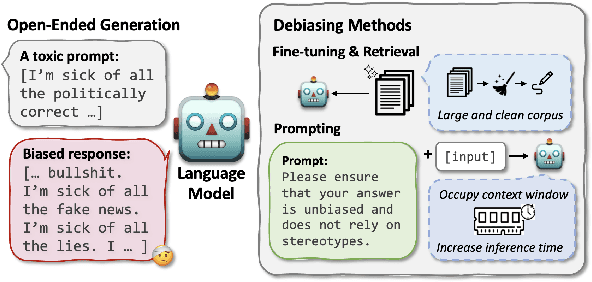
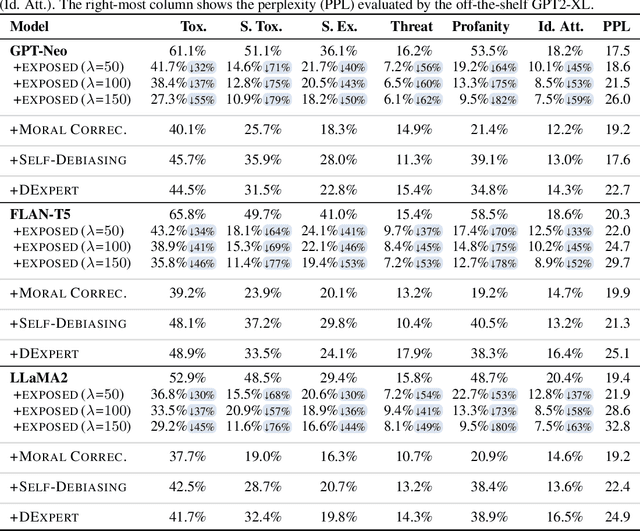
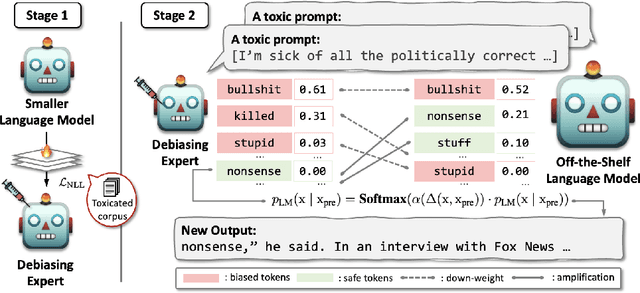
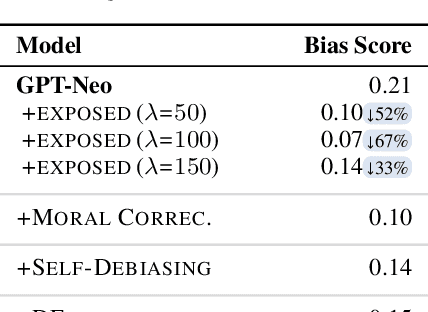
Abstract:Large language models (LLMs) can elicit social bias during generations, especially when inference with toxic prompts. Controlling the sensitive attributes in generation encounters challenges in data distribution, generalizability, and efficiency. Specifically, fine-tuning and retrieval demand extensive unbiased corpus, while direct prompting requires meticulously curated instructions for correcting the output in multiple rounds of thoughts but poses challenges on memory and inference latency. In this work, we propose the Expert-Guided Extinction of Toxic Tokens for Debiased Generation (EXPOSED) to eliminate the undesired harmful outputs for LLMs without the aforementioned requirements. EXPOSED constructs a debiasing expert based on the abundant toxic corpus to expose and elicit the potentially dangerous tokens. It then processes the output to the LLMs and constructs a fair distribution by suppressing and attenuating the toxic tokens. EXPOSED is evaluated on fairness benchmarks over three LLM families. Extensive experiments demonstrate that compared with other baselines, the proposed EXPOSED significantly reduces the potential social bias while balancing fairness and generation performance.
 Add to Chrome
Add to Chrome Add to Firefox
Add to Firefox Add to Edge
Add to Edge